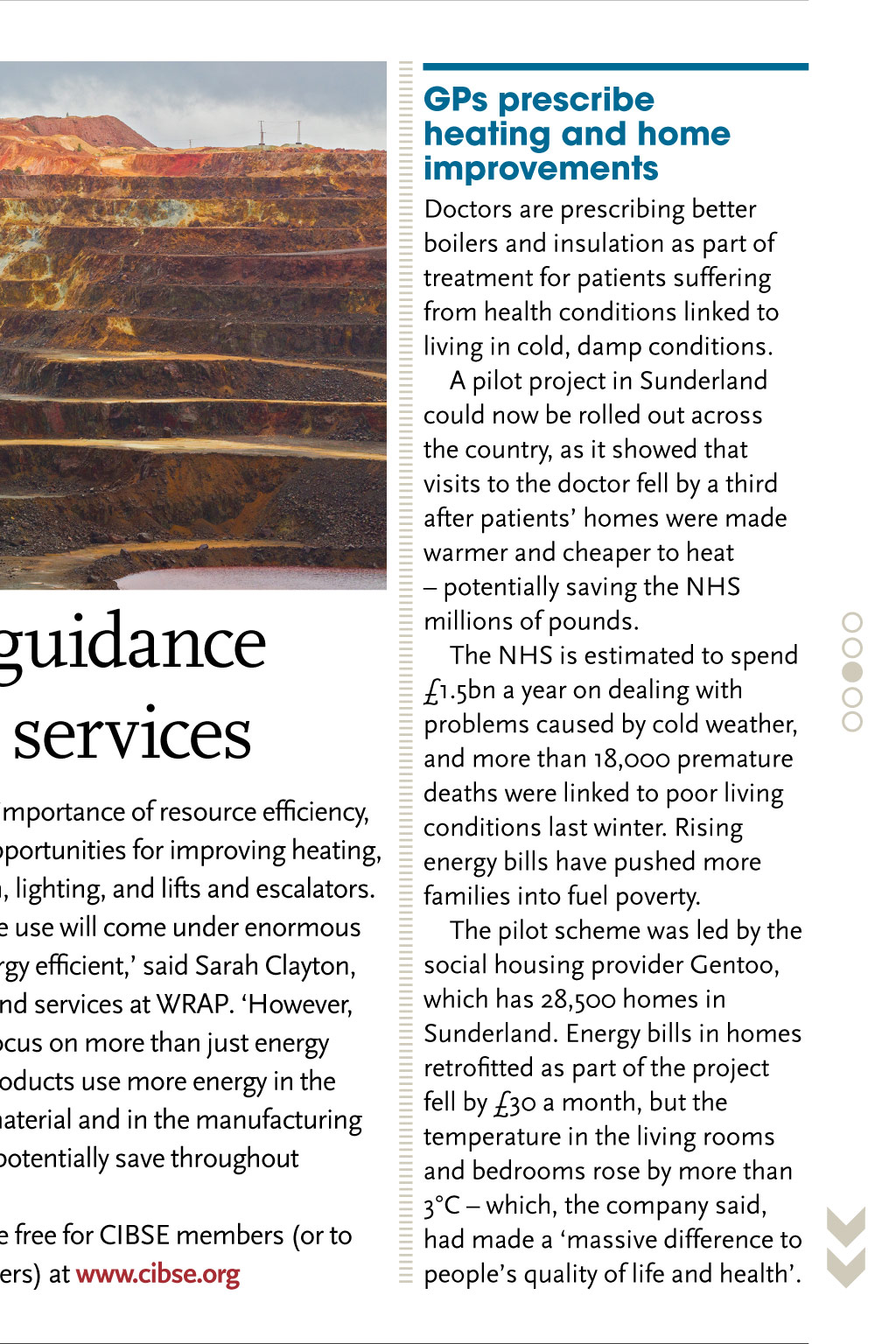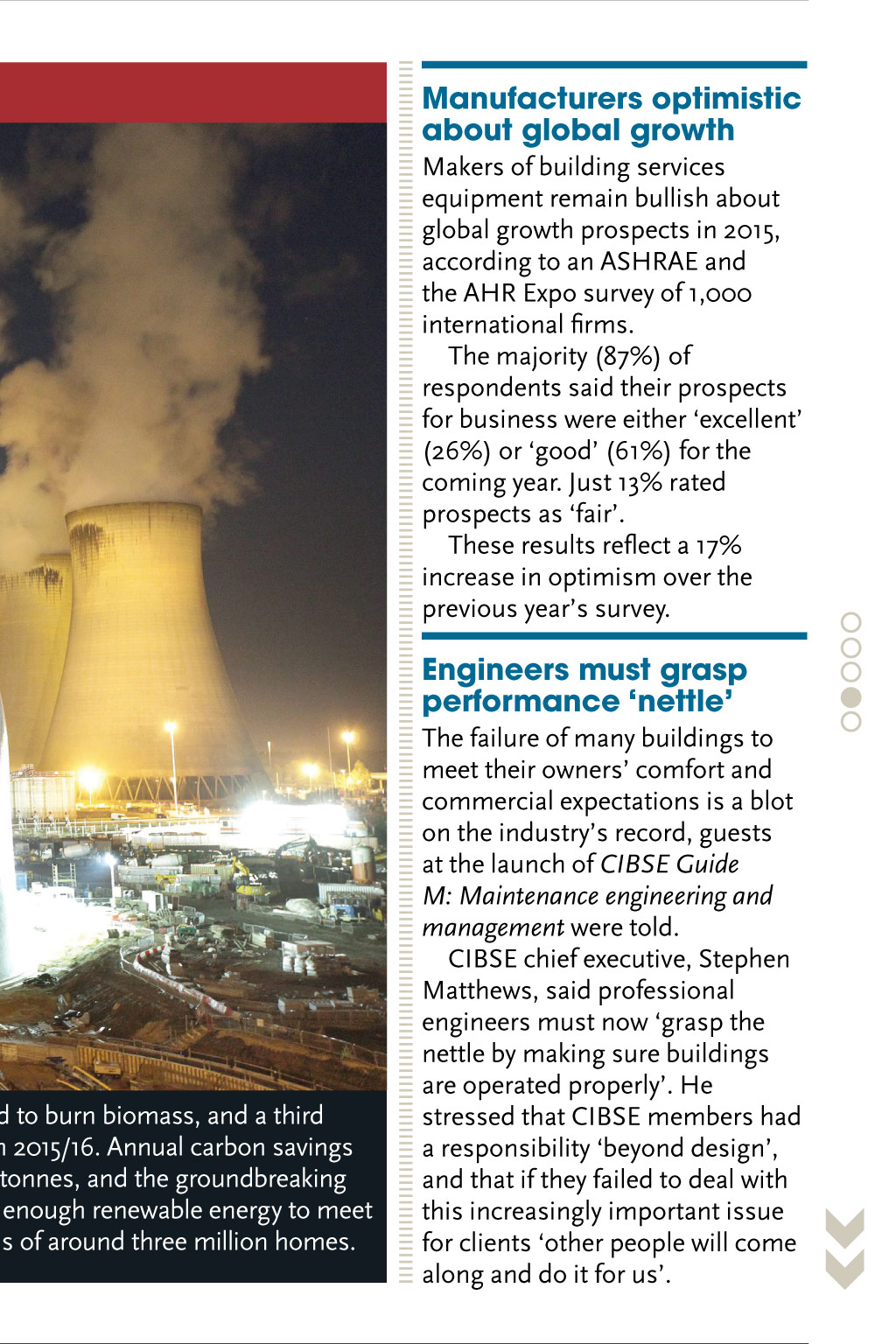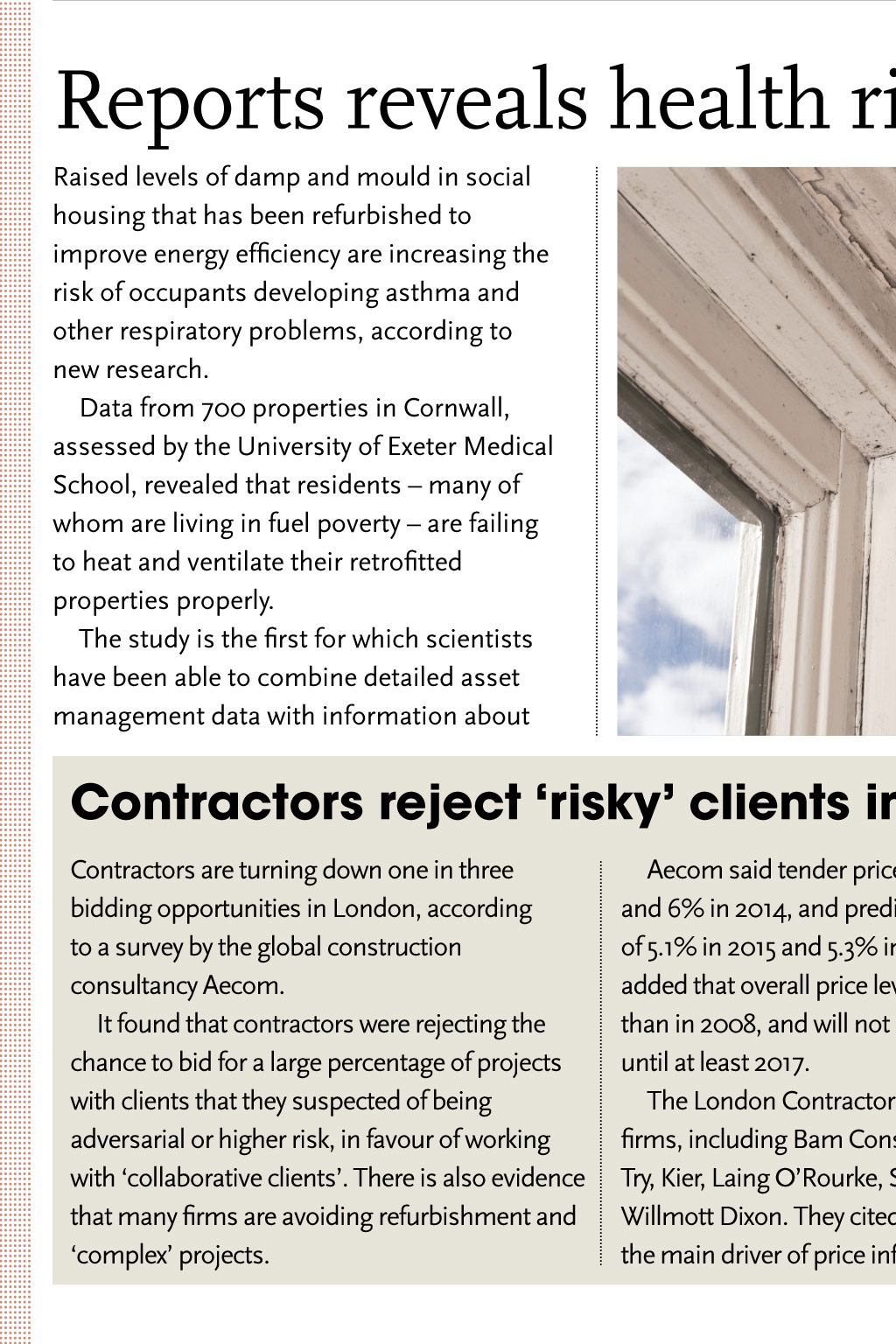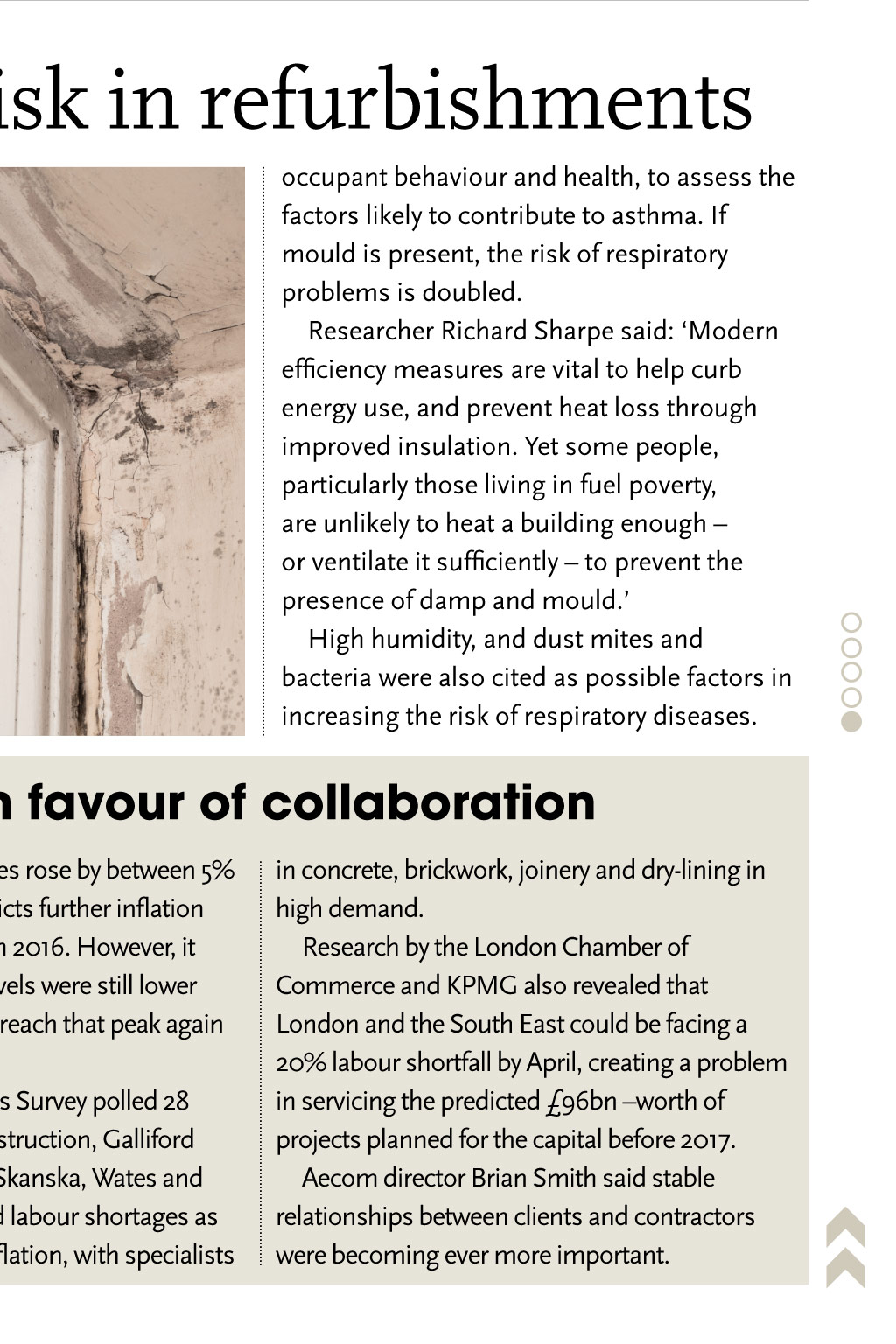




















NEWS All the latest news from around the building industry Design engineers are back in demand A steadily improving economy will see construction firms recruit heavily in the next 12 months, according to the 2015 Hays salary survey for building services. The study showed that 77% of industry bosses planned to expand their workforce next year. As a result, salaries are on the up especially in London, which is leading the construction recovery, said Richard Gelder, UK director for property disciplines at Hays Construction & Property. He added that demand was also widening out to the Home Counties, the South and the South East. Hays found that there is strong demand for design engineers, who are in short supply because of a lack of people entering the Scaling heights: The jobs market is looking brighter in the industry profession, and older employees retiring. The national average salary for a junior design engineer is 22,875, and 26,000 in London. An intermediate design engineer can command an average of 29,167 (35,000 in London), while the national average at senior level is 42,417 (52,000 in the capital). Clare Wildfire, technical director at Mott MacDonald, says the shortage of design engineers and BIM experts could be the tip of the iceberg. We kept a trickle of graduates coming in during the downturn, but the industrys overall intake has been down for the past few years because of lower workloads so the Southampton leads the way in energy efficiency league table l Index designed to spur councils into action Southampton City Council has come out on top of an energy efficiency league table for local councils. The Local Authority Energy Index, developed by Knauf Insulation, analysed 25 English councils with a range of economic backgrounds. It looked at how authorities influence local energy and energy-efficiency agendas, and judged them on four criteria: energy management of their estate, and energy in the community, housing, and infrastructure. Joining Southampton in the top five were Kingston upon Hull, Peterborough, Leeds, and Coventry, while Thurrock, Wirral, Brighton & Hove, Derby, and Swindon were at the bottom of the index. The index is designed to next hurdle the sector faces is a widespread building services skills shortage. However, even companies that currently have the right number of employees should beware; 63% of construction employees planned to move to a new role in the next 12 months, in search of jobs closer to home or with better salaries. The Hays survey showed that 65% of employees in construction are unhappy with their pay, but merely improving this wont be enough to retain some employees. Younger engineers will need support to become chartered, while others may be looking to move up the management ladder. For more, read Scaling the Heights in the Careers Special. Day of the flat-pack waterwheel A waterwheel manufactured by Smith Engineering has started to produce electricity in the Lake District. The four-metre diameter, overshot wheel produces 6kW of power from a continuous water flow of 200 litres per second at The Langdale Hotel and Spa, near Ambleside. The design of the waterwheel was based on research David Cameron meets apprentices in Southampton highlight energy efficiency best practice, said Chris Witte, marketing director Northern Europe at Knauf Insulation. It looks at those successes and seeks to better understand the barriers that have prevented some councils from doing more, he said. Dr Steve Fawkes, who undertook research on the index, said that some local councils have been cutting back on energy-efficiency resources. He added: They spend too much on reporting CRC data, rather than developing actual projects. Theres a lack of support and capacity. Fawkes said the index was useful for measuring performance, and spurring local councils into action, and added that more authorities should adopt ISO50001, which covers best practice. Energy management is the foundation stone for good energy efficiency. Only one council has adopted ISO50001 we would like to see more, he said. For the full league table visit www.laenergyindex.co.uk by Smith and the University of Cumbria, and was delivered to site as a flat-pack kit, without the need for a crane. Danes give Scots heating ideas The Danish Energy Agency is to share its experience of district heating and energy efficiency with the Scottish government. Scotland aims to reduce its greenhouse gas emissions by 42%, and energy consumption by 12% by 2020, compared with 1990 figures. GPs prescribe heating and home improvements CIBSE Resource efficiency guidance explores impact of building services CIBSE and the governments resource efficiency consultancy, WRAP, have produced joint guidance on resource efficiency in the built environment. TM56: Resource efficiency of building services reflects the growing pressure on resources, and the desire to create more circular economies. New regulatory requirements and demand for lower-impact products are expected to stimulate annual growth of 22.8% in the global sustainable building industry between now and 2017. TM56 explores the impact of building services in manufacturing, construction, maintenance and disposing of equipment at end of life. It describes the principles and importance of resource efficiency, and sets out the opportunities for improving heating, cooling, ventilation, lighting, and lifts and escalators. The products we use will come under enormous pressure to be energy efficient, said Sarah Clayton, head of products and services at WRAP. However, it is important to focus on more than just energy efficiency; some products use more energy in the extraction of raw material and in the manufacturing process than they potentially save throughout their operation. TM56 is available free for CIBSE members (or to buy for non-members) at www.cibse.org DRAX ON BIOMASS TRACK Doctors are prescribing better boilers and insulation as part of treatment for patients suffering from health conditions linked to living in cold, damp conditions. A pilot project in Sunderland could now be rolled out across the country, as it showed that visits to the doctor fell by a third after patients homes were made warmer and cheaper to heat potentially saving the NHS millions of pounds. The NHS is estimated to spend 1.5bn a year on dealing with problems caused by cold weather, and more than 18,000 premature deaths were linked to poor living conditions last winter. Rising energy bills have pushed more families into fuel poverty. The pilot scheme was led by the social housing provider Gentoo, which has 28,500 homes in Sunderland. Energy bills in homes retrofitted as part of the project fell by 30 a month, but the temperature in the living rooms and bedrooms rose by more than 3C which, the company said, had made a massive difference to peoples quality of life and health. Manufacturers optimistic about global growth Makers of building services equipment remain bullish about global growth prospects in 2015, according to an ASHRAE and the AHR Expo survey of 1,000 international firms. The majority (87%) of respondents said their prospects for business were either excellent (26%) or good (61%) for the coming year. Just 13% rated prospects as fair. These results reflect a 17% increase in optimism over the previous years survey. Engineers must grasp performance nettle Shepherd has completed new biomass facilities that allow the formerly coal-fired Drax power station, in Yorkshire, to burn up to 14,000 tonnes of biomass and generate up to 1,260 MW of renewable electricity each day. Two of six generating units have now been converted to burn biomass, and a third will be completed in 2015/16. Annual carbon savings will be around 12m tonnes, and the groundbreaking facility will produce enough renewable energy to meet the equivalent needs of around three million homes. The failure of many buildings to meet their owners comfort and commercial expectations is a blot on the industrys record, guests at the launch of CIBSE Guide M: Maintenance engineering and management were told. CIBSE chief executive, Stephen Matthews, said professional engineers must now grasp the nettle by making sure buildings are operated properly. He stressed that CIBSE members had a responsibility beyond design, and that if they failed to deal with this increasingly important issue for clients other people will come along and do it for us. Reports reveals health risk in refurbishments Raised levels of damp and mould in social housing that has been refurbished to improve energy efficiency are increasing the risk of occupants developing asthma and other respiratory problems, according to new research. Data from 700 properties in Cornwall, assessed by the University of Exeter Medical School, revealed that residents many of whom are living in fuel poverty are failing to heat and ventilate their retrofitted properties properly. The study is the first for which scientists have been able to combine detailed asset management data with information about occupant behaviour and health, to assess the factors likely to contribute to asthma. If mould is present, the risk of respiratory problems is doubled. Researcher Richard Sharpe said: Modern efficiency measures are vital to help curb energy use, and prevent heat loss through improved insulation. Yet some people, particularly those living in fuel poverty, are unlikely to heat a building enough or ventilate it sufficiently to prevent the presence of damp and mould. High humidity, and dust mites and bacteria were also cited as possible factors in increasing the risk of respiratory diseases. Contractors reject risky clients in favour of collaboration Contractors are turning down one in three bidding opportunities in London, according to a survey by the global construction consultancy Aecom. It found that contractors were rejecting the chance to bid for a large percentage of projects with clients that they suspected of being adversarial or higher risk, in favour of working with collaborative clients. There is also evidence that many firms are avoiding refurbishment and complex projects. Aecom said tender prices rose by between 5% and 6% in 2014, and predicts further inflation of 5.1% in 2015 and 5.3% in 2016. However, it added that overall price levels were still lower than in 2008, and will not reach that peak again until at least 2017. The London Contractors Survey polled 28 firms, including Bam Construction, Galliford Try, Kier, Laing ORourke, Skanska, Wates and Willmott Dixon. They cited labour shortages as the main driver of price inflation, with specialists in concrete, brickwork, joinery and dry-lining in high demand. Research by the London Chamber of Commerce and KPMG also revealed that London and the South East could be facing a 20% labour shortfall by April, creating a problem in servicing the predicted 96bn worth of projects planned for the capital before 2017. Aecom director Brian Smith said stable relationships between clients and contractors were becoming ever more important. "